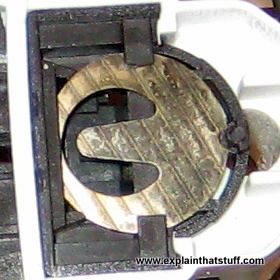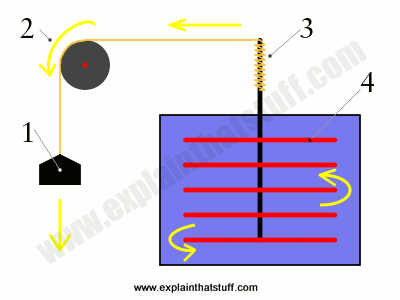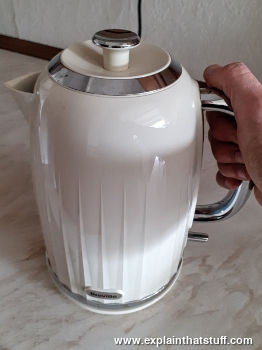
Electric kettles
by Chris Woodford. Last updated: February 16, 2023.
Cars run on gasoline... and people run on tea and coffee (at least in my house)! If you drink coffee or tea by the bucket, you'll be glad someone once had the gumption to invent a super-efficient way of turning cold water into hot—namely, the electric kettle (also known as an electric tea kettle). Fill it with water, plug it in, switch it on, and in a couple of minutes you have piping hot water ready for drinking or cooking. How exactly does a kettle work? Why does it take so long to boil? And how does it know when to switch itself off? Let's take a closer look!
Photo: An electric kettle is a convenient way of making heat energy from electricity. It's a water heater, but it's also an energy conversion device that illustrates one of the most basic laws of physics: the conservation of energy (discussed further below).
Sponsored links
Contents
What is an electric kettle?
Kettles are among the simplest of household appliances. Lift the lid and peer inside and you'll see, at the very bottom of the water container, a coil of thick metal called the heating element. When you plug the kettle into an electrical outlet, a large electric current flows into the heating element. The element's resistance (the tendency any material has to stop electricity flowing through it) turns the electrical energy into heat. In other words, the element gets hot. Since it's in direct contact with cold water, the heat passes to the water by conduction and rapidly warms it up too.
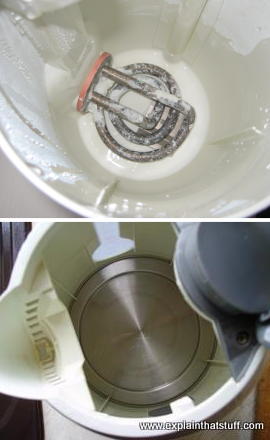
Photo: Top: The heating element inside the base of the electric kettle shown in our upper photo. Bottom: In some kettles, the element is concealed from view, under the inside floor, to stop it from "furring up" with limescale. This is a neater design, but it does make for a much noisier kettle.
How long does a kettle take to boil?
You can boil water in all kinds of ways—even in a simple pan on an open fire or stove—though an enclosed kettle is usually much faster: it stops heat escaping, allows the pressure to rise faster (remember that water boils when its saturated vapor pressure equals atmospheric pressure), and helps the water to boil more quickly. But do you ever get frustrated at how long it takes your kettle to boil? Don't! The amazing thing is that your kettle boils as quickly as it does—and here's why.
If you keep pumping heat energy into the bottom of a kettle (faster than heat is escaping through the top and the sides), sooner or later the water inside it will boil. A basic law of physics called the conservation of energy tells us that if you need to boil a liter of water, starting from the same temperature, you'll always have to add the same amount of energy to do it. Whether you use a camp fire or a kettle, a microwave or some amazing stirring device in the manner of James Prescott Joule (see box below), the amount of energy you have to put into the water to make it boil is exactly the same. That doesn't mean every method of boiling water is 100 percent efficient, however, for reasons I'll return to in a moment.
Let's say you start with 1 liter (roughly 1 kilogram, 2.2 lbs) of cold water at about 10°C (50°F) and you want to raise it 90°C to its boiling point (100°C or 212°F). The amount of energy you need is 4.2 × 1000 grams × 90 degrees = 378,000 joules or 378 kJ.
The mysterious "4.2" is a constant value called the specific heat capacity of water. Every material has a different specific heat capacity, which is simply the amount of energy you have to put in to raise the temperature of one gram of the material by one degree centigrade. You need to add 4.2 joules of energy to raise the temperature of 1 gram of water by 1°C, so water's specific heat capacity is 4.2 J/g/°C.
378kJ to boil a liter of water is rather more energy than you might think. An energy-efficient lamp rated at 10 watts uses 10 joules of energy every second (because 1 watt means using one joule per second), so it would take it 37,800 seconds—about 10.5 hours—to use as much energy as our kettle uses in a single boil!

Artwork: Kettles use a lot of energy to boil water, but do the job quickly (in about 2.5 minutes) because they work at high power. With the same amount of energy, you could power a microwave oven for about 8 minutes, a laptop computer for an hour and 20 minutes, or an energy-saving lamp for about 10.5 hours.
If you're using an electric kettle rated at 2400 watts, that means it's consuming 2400 joules of electrical energy per second and putting (roughly) the same amount of energy into the water as heat each second as well. Divide 378,000 by 2400 and you find it takes the kettle about 160 seconds to do the job, which sounds about right—an electric kettle generally does take about 2–3 minutes to boil. An old proverb says a watched pot (kettle) never boils, but that dates from the time when most people used to boil water on hideously inefficient open coal fires. An electric kettle can boil water in just a couple of minutes because it can add heat energy to the water much more quickly and efficiently than an open fire (which allows heat to escape in all directions).
If your kettle were rated at something like 2400 watts (W) and you were using a UK power supply of 240 volts (V), that means the current passing through the element would be 2400 / 240 or 10 amps (A). By household standards, that's a hefty current: in comparison, the little charger I have for my iPod draws a maximum current of 0.67 amps—the kettle is using 15 times more! So the answer to how an electric kettle works so quickly is by using a relatively large electric current. The amount of heat produced is proportional to the current squared, so bigger currents produce much more heat—and heat things much more quickly—than smaller ones.
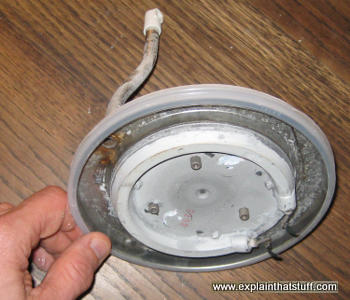
Photo: The concealed heating element from a typical modern kettle, looking from below. The element is sealed in the light gray central part and (if you look closely) you can just see its two terminals poking out on the bottom right. The darker gray rim (the bit my thumb is touching) is a rubbery-plastic gasket that seals the heating element inside the bottom of the kettle and stops water seeping through. The long tube at the top carries steam from inside the kettle down to a thermostat that switches the element off at the right time (as explained below).
How efficient is a kettle?
I've just said you need to use the same amount of energy to boil water however you do it, which suggests every method of boiling water is just as efficient. What I mean is that a fixed amount of water takes a fixed amount of energy to boil. If you boil water on a gas stove in an open pan, you'll have to use more energy than if you use an electric tea kettle, because more energy is wasted from the top and from the gas flame. If you use a microwave, you have to power the turntable and there's even energy wasted making that awful humming sound.
A few years ago, physicist Tom Murphy cranked the numbers to figure out the efficiencies of different boiling methods. He found that electric kettles are by far the most efficient, although if you adjust for the fact that power plants produce electricity in wasteful ways, they're rather less impressive. (So, for example, if you're interested in cutting carbon dioxide emissions, you do need to consider how your electricity is made.) Another key finding of Tom's was that how fast a kettle switches off dramatically affects its efficiency. And that's exactly what you'd expect from the physics, because making steam from hot water requires a great deal of energy.
But if you're trying to find out whether one electric kettle is more or less efficient than another, forget it. Basic electric kettles are all about the same. The key to improving efficiency is to use no more water than you need and to make sure your kettle switches off as soon as it boils.
How do instant hot water boilers work?
If you're tired of waiting and you want your kettle to boil faster, there are only two things you can do. One is to use more electric current—in other words, buy a more powerful kettle; the other use is to use less water.
"Instant" water boilers/dispensers (such as the Breville Hot Cup and the Morphy Richards Meno), which can boil as little as a cupful of water really quickly, combine these methods. They use a more powerful heating element than an ordinary kettle (typically 3000 watts or more) and they're designed so the element can operate safely in contact with only a small amount of water. If you're boiling only (say) a quarter of a liter of water, you need only a quarter as much energy—say 100,000 joules. And if you're supplying that energy with a 3000 watt element, do the math and you'll find you can do it in about 30 seconds instead of 2.5 minutes. Can you see another great benefit here? If you're boiling an entire kettle to make just a single hot drink, you're effectively wasting three quarters of the energy you're consuming. Boiling only as much water as you need saves you a significant amount of money—and helps the environment too.
How does a kettle know when to switch off?

Artwork: How an electric jug kettle switches off. There's a steam vent and tube (yellow, 43 and 44) leading down from the top of the water chamber (gray, 38) to a bimetallic thermostat and switch (orange and red, 1 and 2). When the kettle boils, steam whooshes down this tube, heats the thermostat, and makes it flip open, switching off the heating element (green, 39) and stopping the water from boiling any more. Artwork from US Patent 4,357,520: Electric water-boiling container having switch-on dry and stream sensitive thermally responsive control units by John C. Taylor, courtesy of US Patent and Trademark Office.
Early electric kettles came with built-in danger: it was relatively easy to switch them on, go off and do a chore or two, and then forget about them. If you were lucky, when you came back a few minutes later, you'd find your kitchen filled with clouds of steam. If you were unlucky, your kettle element might burn out, blow a fuse, or even start a fire.
Thankfully, virtually all modern kettles switch themselves off automatically using thermostats (mechanical, electrical, or electronic devices that respond to changes in temperature). Many are based on designs developed by English inventor John C. Taylor, whose companies Otter Controls and Strix Ltd have developed more than a billion thermostats of this kind worldwide.
How do they work? The simplest ones are mechanical and use a bimetallic thermostat (described in our main article on thermostats) integrated into the element unit at the bottom of the kettle. It consists of a disc of two different metals bonded tightly together, one of which expands faster than the other as the temperature rises. Normally the thermostat is curved in one direction, but when the hot water reaches boiling point, the steam produced hits the bimetallic thermostat and makes it suddenly snap and flex in the opposite direction, a bit like an umbrella turning inside out in the wind. When the thermostat snaps open, it pushes a lever that trips the circuit, cuts off the electric current, and safely switches off the kettle. More sophisticated kettle thermostats (used in systems such as the fashionable Marco Über coffee boiler) are entirely electronic and allow water to be heated to precise temperatures and maintained there indefinitely by repeatedly switching the current on and off.
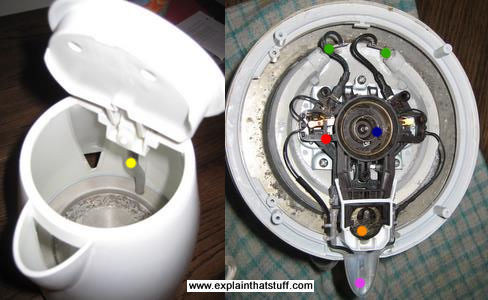
Photo: (above) Here's what a typical Strix thermostat-switch looks like in reality. I've used dots the same color as in the artwork above to show the key parts in this old, disassembled kettle. The steam tube (yellow) carries steam down to the bimetallic thermostat. The thermostat (orange) switches the kettle off. A switching unit (red) and several wires connect the thermostat, the power on switch (pink), and the cordless connector (dark blue) to the heating element's two terminals (green). The thermostat and switch are screwed to the bottom of the light gray, concealed heating element (shown in the photo higher up this page).
Photo: (below) A closeup of the bimetallic thermostat (shown by the orange dot in the other photo).
